Combined Space–Time Analysis of Geodetic and Geological Surveys for Evaluation of the Reliability of the Position of Points in the Geodynamic Network of the City of Zagreb
Abstract
1. Introduction
2. Geologic Framework and Tectonic Evolution in the Zagreb Area
3. Geodetic Movement Model
3.1. Establishment of the Geodynamic Network
3.2. GPS Measurements
3.3. Processing of GPS Measurements
4. Discussion
4.1. Analysis of the Movement of the Geodynamic Points
4.2. Tectonic Movements
5. Conclusions
- The largest amplitudes of tectonic movements are present in the western part of Medvednica, then along the zone of Zagreb fault and west of Zagreb, around the fault zone of Stubica-Kašina and in parts of Vukomeričke gorice.
- The resulting different average movement directions, as in Medvednica, show that regional tectonic movements initiate retrograde rotation of its structural blocks. This is especially expressed with the different directions of movements of Zelinska gora.
- In the western part of Medvednica, positive movements (elevation) were recorded in certain points. These parts of Medvednica directly oppose the action of regional tectonic movements. In contrary, in the eastern part of Medvednica, mainly in the wider area around the fault zone Stubica–Kašina, negative movements (subsidence) at geodynamic points are prevailing. This indicates that in the Medvednica area, a general rotation around the obliquely inclined axis in space is present.
Author Contributions
Funding
Conflicts of Interest
References
- Herak, D.; Herak, M.; Tomljenović, B. Seismicity and earthquake focal mechanisms in North-Western Croatia. Tectonophysics 2009, 485, 212–220. [Google Scholar] [CrossRef]
- Herak, M.; Allegretti, I.; Herak, D.; Ivančić, I.; Kuk, K.; Marie, K.; Markušić, S.; Sović, I. Seismic hazard maps of Croatia. In Proceedings of the Geophysical Challenges of the 21st Century, Zagreb, Croatia, 2 December 2011. [Google Scholar]
- Prelogović, E.; Cvijanović, D. Potres u Medvednici 1880. godine. Geol. Vjesn. 1981, 34, 137–146. (In Croatian) [Google Scholar]
- Pribičević, B.; Medak, D.; Prelogović, E.; Đapo, A. Geodinamika Prostora Grada Zagreba; Scientific monograph: Faculty of Geodesy; University of Zagreb: Zagreb, Croatia, 2007. (In Croatian) [Google Scholar]
- Decker, K. Miocene tectonics at the Alpine-Carpathian junction and the evolution of the Vienna Basin. Mitt. Ges. Geol. Bergbaustud. Österr 1996, 41, 33–44. [Google Scholar]
- Prelogović, E.; Jamičić, D.; Aljinović, B.; Velić, J.; Saftić, B.; Dragaš, M. Dinamika nastanka struktura južnog dijela panonskog bazena. In Proceedings of the First Croatian Geological Congress, Opatija, Croatia, 18–21 October 1995; pp. 481–486. (In Croatian). [Google Scholar]
- Pribičević, B. Uporaba Geološko-geofizičnih in Geodetskih baz Podatkov za Računanje Ploskve Geoida Republike Slovenije. In Znanstvena Monografija; Univerza v Ljubljani, Fakulteta za gradbeništvo in geodezije: Ljubljana, Slovenia, 2001; pp. 1–115. [Google Scholar]
- Medak, D.; Pribičević, B. Geodinamička mreža Grada Zagreba. In Zbornik Geodetskog Fakulteta Sveučilišta u Zagrebu Povodom 40. Obljetnice Samostalnog Djelovanja 1962–2002; University of Zagreb: Zagreb, Croatia, 2002; pp. 145–156. [Google Scholar]
- Medak, D.; Pribičević, B.; Prelogović, E. Determination of the recent structural fabric in the Alps-Dinarides area by a combination of geodetic and geologic methods. In Raziskave s Področja Geodezije in Geofizike; Brilly, M., Ed.; Slovensko združenje za geodezije in geofiziko: Ljubljana, Slovenia, 2002; pp. 57–64. [Google Scholar]
- Ben, A.D.; Finetti, I.; Rebez, A.; Slejko, D. Seismicity and seismotectonics at the Alps-Dinarides contact. Boll. Geof. Teor. Appl. 1991, 33, 155–176. [Google Scholar]
- Prelogović, E. Preliminarni Model Potresnih Izvora Slovenije; RGN Fakultet: Zagreb, Croatia, 1996. (In Croatian) [Google Scholar]
- Kuk, V.; Prelogović, E.; Sović, L.; Kuk, K.; Marić, K. Seizmološke i seizmotektonske značajke šireg zagrebačkog područja. Građevinar 2000, 52, 647–653. (In Croatian) [Google Scholar]
- Herak, M.; Herak, D.; Markušić, S. Revision of the earthquake catalogue and seismicity of Croatia, 1908–1992. Terra Nova 1996, 8, 86–94. [Google Scholar] [CrossRef]
- Ivančić, I.; Herak, D.; Markušić, S.; Sović, I.; Herak, M. Seismicity of Croatia in the period 2002–2005. Geofizika 2006, 2, 1–17. [Google Scholar]
- Ivančić, I.; Herak, D.; Herak, M.; Allegretti, I.; Fiket, T.; Kuk, K.; Markušić, S.; Prevolnik, S.; Sović, I.; Dasović, I.; et al. Seismicity of Croatia in the period 2006–2015. Geofizika 2018, 1, 69–98. [Google Scholar] [CrossRef]
- Pribičević, B.; Medak, D.; Đapo, A. Progušćenje točaka Geodinamičke mreže Grada Zagreba u podsljemenskoj zoni. Geodetski List 2007, 61, 247–258. (In Croatian) [Google Scholar]
- Matoš, B.; Tomljenović, B.; Trenc, N. Identification of tectonically active areas using DEM: A quantitative morphometric analysis of Mt. Medvednica, NW Croatia. Geol. Q. 2014, 58, 51–70. [Google Scholar] [CrossRef][Green Version]
- Pribičević, B.; Đapo, A. Analiza pomaka na Geodinamičkoj mreži Grada Zagreba iz različitih vremenskih epoha. Geodetski List 2016, 70, 207–230. (In Croatian) [Google Scholar]
- Pribičević, B.; Đapo, A.; Medak, D. Geodetsko-geološka istraživanja na širem zagrebačkom području oslonjena na Geodinamičku mrežu Grada Zagreba. Geodetski List 2011, 65, 1–19. (In Croatian) [Google Scholar]
- Đapo, A.; Pribičević, B.; Medak, D.; Prelogović, E. Correlation between Geodetic and Geological Models in the Geodynamic Network of the City of Zagreb. Rep. Geod. 2009, 86, 115–122. [Google Scholar]
- Lučić, D.; Saftić, B.; Krizmanić, K.; Prelogović, E.; Britvić, V.; Mesić, I.; Tadej, J. The Neogene evolution and hydrocarbon potential of the Pannonian Basin in Croatia. Mar. Pet. Geol. 2001, 18, 133–147. [Google Scholar] [CrossRef]
- Vrabec, M.; Fodor, L. Late Cenozoic tectonics of Slovenia: Structural styles at the North-eastern corner of the Adriatic microplate. In The Adria Microplate: GPS Geodesy, Tectonics and Hazards, 151–168; Springer: Amsterdam, The Netherlands.
- Tomljenović, B.; Csontos, L. Neogene–Quaternary structures in the border zone between Alps, Dinarides and Pannonian Basin. Int. J. Earth Sci. 2001, 90, 560–578. [Google Scholar] [CrossRef]
- Prelogović, E.; Kuk, V. Seizmotektonska aktivnost zapadnog dijela Hrvatske. In Proceedings of the the Scientific Conference “Andrija Mohorovičić”; Bajić, A., Ed.; Državni hidrometeorološki zavod: Zagreb, Croatia, 1998; pp. 115–124. (In Croatian) [Google Scholar]
- Basch, O. (1983a): Osnovna Geološka Karta SFRJ 1:100.000, List Ivanić-Grad L33–81.–Geološki Zavod, Zagreb; OOUR za Geologiju i Paleontologiju (1969–1976); Savezni Geološki Institut: Beograd, Jugoslavija, 1981. [Google Scholar]
- Basch, O. (1983b): Osnovna Geološka karta SFRJ 1:100.000, Tumač za list Ivanić-Grad L33–81.–Geološki Zavod, Zagreb (1980); Savezni Geološki Institut: Beograd, Jugoslavija, 1980. [Google Scholar]
- Gerasimenko, M.D.; Shestakov, N.V.; Kato, T. On optimal geodetic network design for fault-mechanics studies. Earth Planets Space 2000, 52, 985–987. [Google Scholar] [CrossRef]
- Feigl, K.L.; Duncan, C.A.; Bock, Y.; Dong, D.; Donnellan, A.; Hager, H.B.; Herring, T.A.; Jackson, D.D.; Jordan, T.H.; King, R.W.; et al. Space geodetic measurement of crustal deformation in central and southern California, 1984–1992. J. Geophys. Res. 1993, 98, 21677–21712. [Google Scholar] [CrossRef]
- Dong, D.; Herring, T.; King, R. Estimating regional deformation from a combination of space and terrestrial geodetic data. J. Geod. 1998, 72, 200–214. [Google Scholar] [CrossRef]
- Herring, T.; Davis, J.; Shapiro, I. Geodesy by radio astronomy: The aplication of Kalman filtering to Very Long Baseline Interferometry. J. Geophys. Res 1990, 95, 12561–12581. [Google Scholar] [CrossRef]
- Herring, T.A.; King, R.W.; Floyd, M.A.; McClusky, S.C. Introduction to GAMIT/GLOBK. In Proceedings of the GAMIT–GPS Analysis at MIT; Department of Earth, Atmospheric, and Planetary Sciences Massachusetts Institute of Technology: Cambridge, MA, USA, 2015. [Google Scholar]
- Herring, T.A.; King, R.W.; Floyd, M.A.; McClusky, S.C. GAMIT Reference Maunal 10.6. In Proceedings of the GAMIT–GPS Analysis at MIT; Department of Earth, Atmospheric, and Planetary Sciences Massachusetts Institute of Technology: Cambridge, MA, USA, 2015. [Google Scholar]
- Reilinger, R.; McClusky, S.; Vernant, P.; Lawrence, S.; Ergintav, S.; Cakmak, R.; Ozener, H.; Kadirov, F.; Guliev, I.; Stepanyan, R.; et al. GPS Constraints on Continental Deformation in the Africa-Arabia-Eurasia Continental Collision Zone and implications for the Dynamics of Plate Interactions. J. Geophys. Res. 2006, 111, 2156–2202. [Google Scholar] [CrossRef]
- McClusky, S.; Balassanian, S.; Barka, A.; Demir, C.; Ergintav, S.; Georgiev, I.; Gurkan, O.; Hamburger, M.; Hurst, K.; Kahle, H.; et al. Global Positioning System constraints on plate kinematics and dynamics in the eastern Mediterranean and Caucasus. J. Geophys. Res. 2000, 105, 5695–5719. [Google Scholar] [CrossRef]
- Davies, P.; Blewitt, G. Methodology for global geodetic time series estimation: A new tool for geodynamics. J. Geophys. Res. Space Phys. 2000, 105, 11083–11100. [Google Scholar] [CrossRef]
- Premužić, M.; Đapo, A.; Bačić, Ž.; Pribičević, B. Accuracy analysis of point velocities determined by different software packages and GNSS measurement processing methods. Tech. J. 2020, 14, 1. [Google Scholar] [CrossRef]
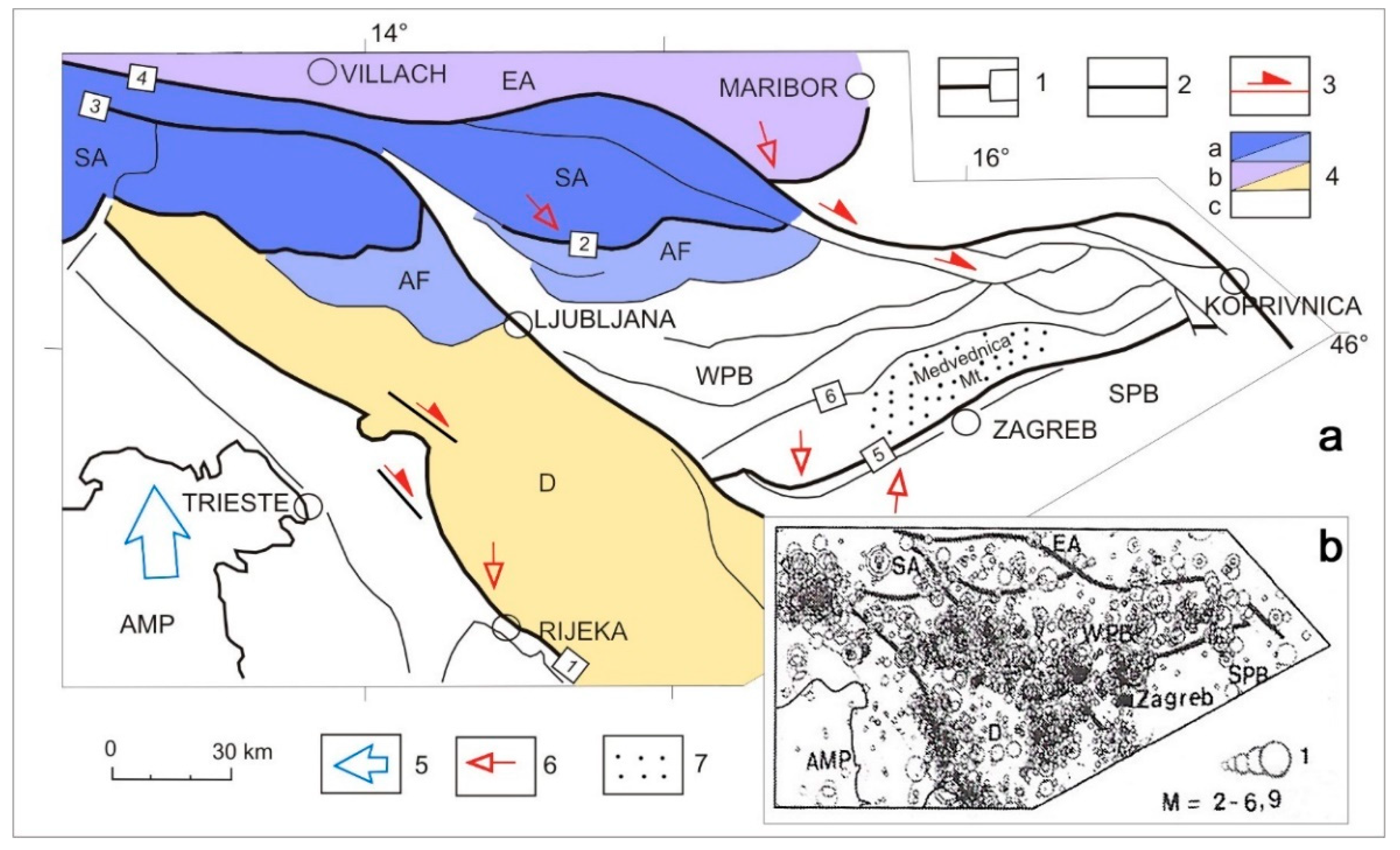
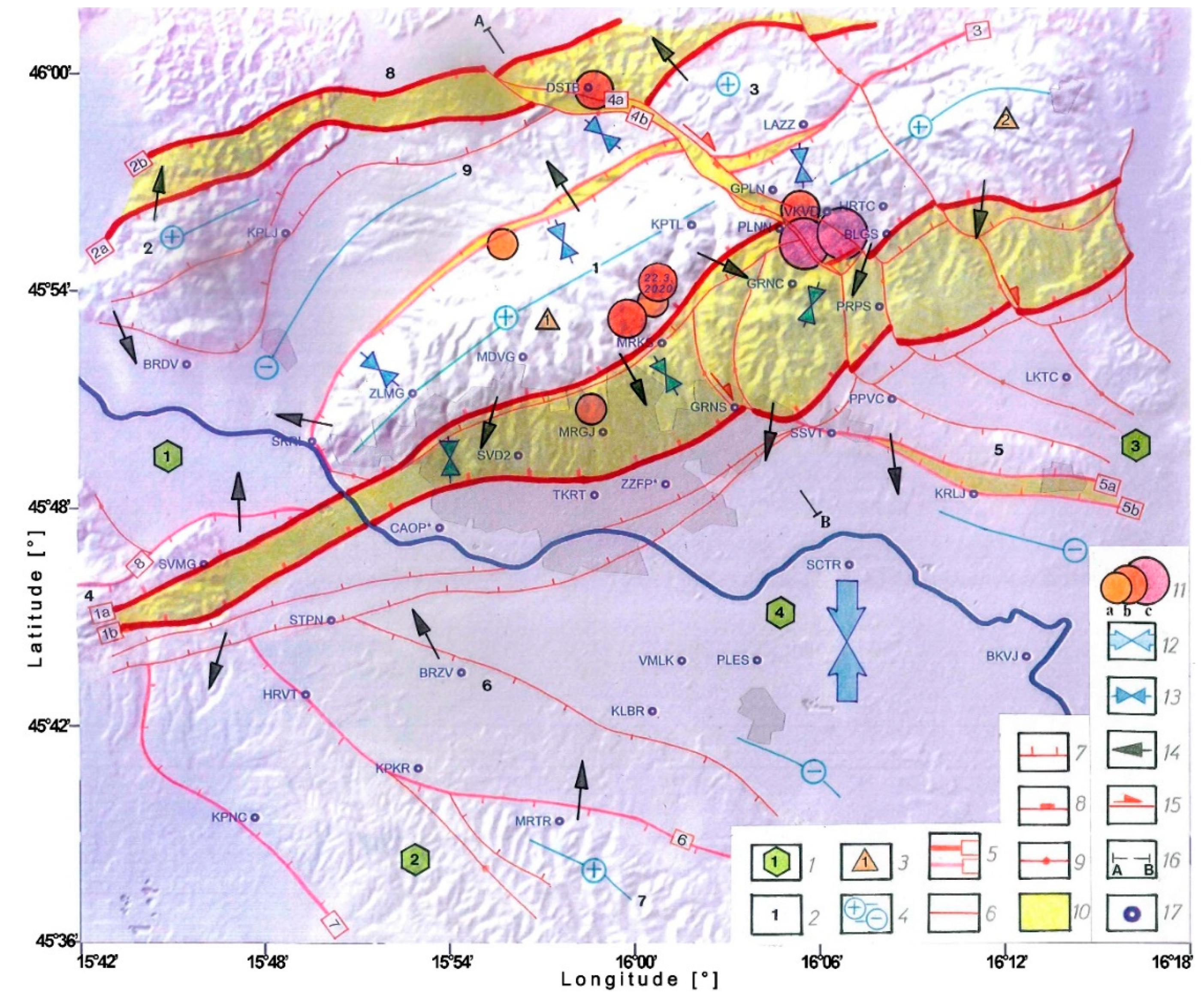

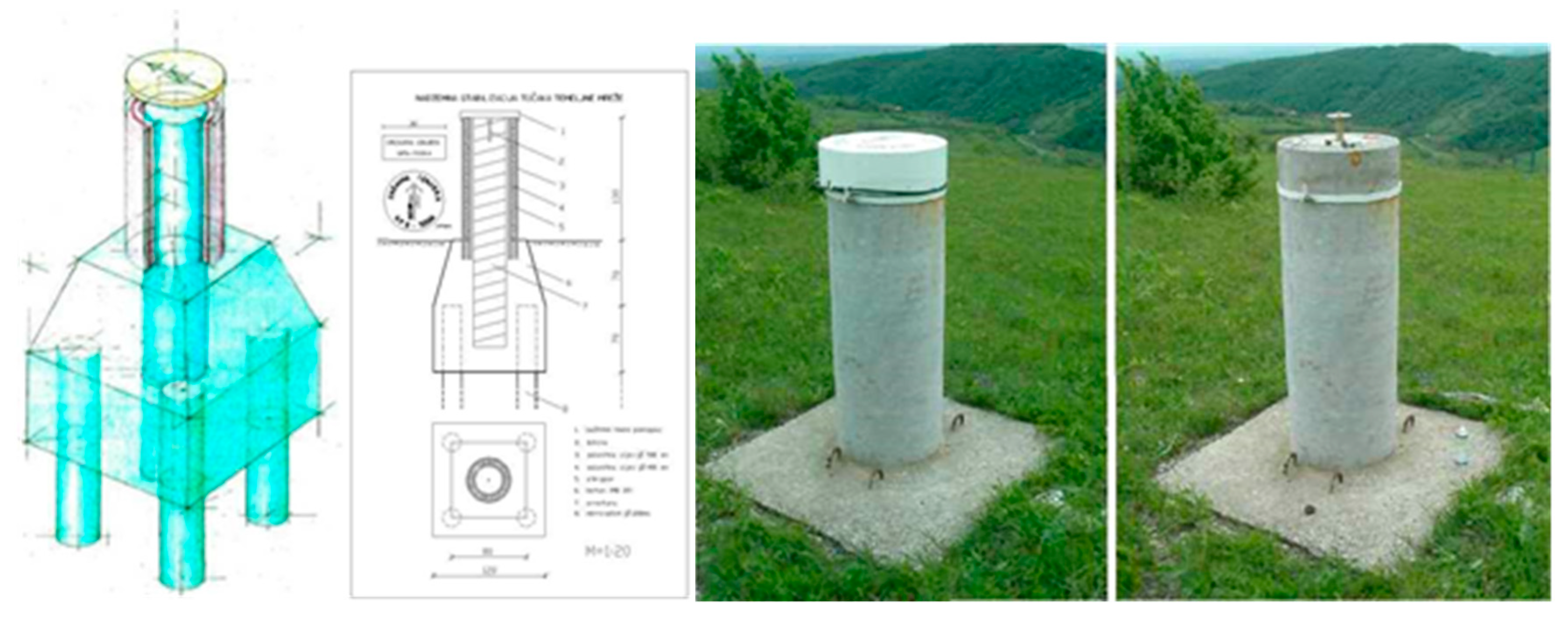
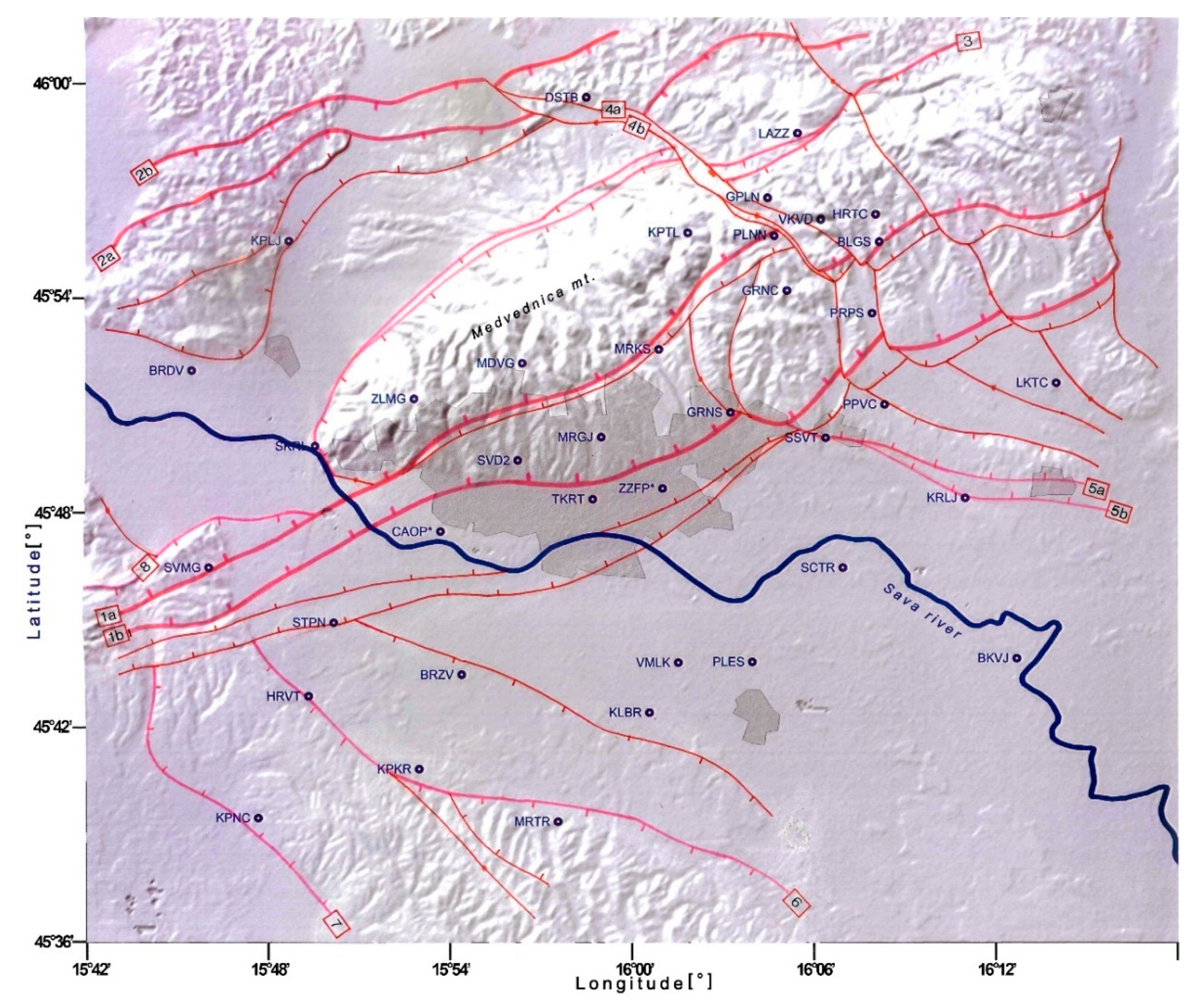
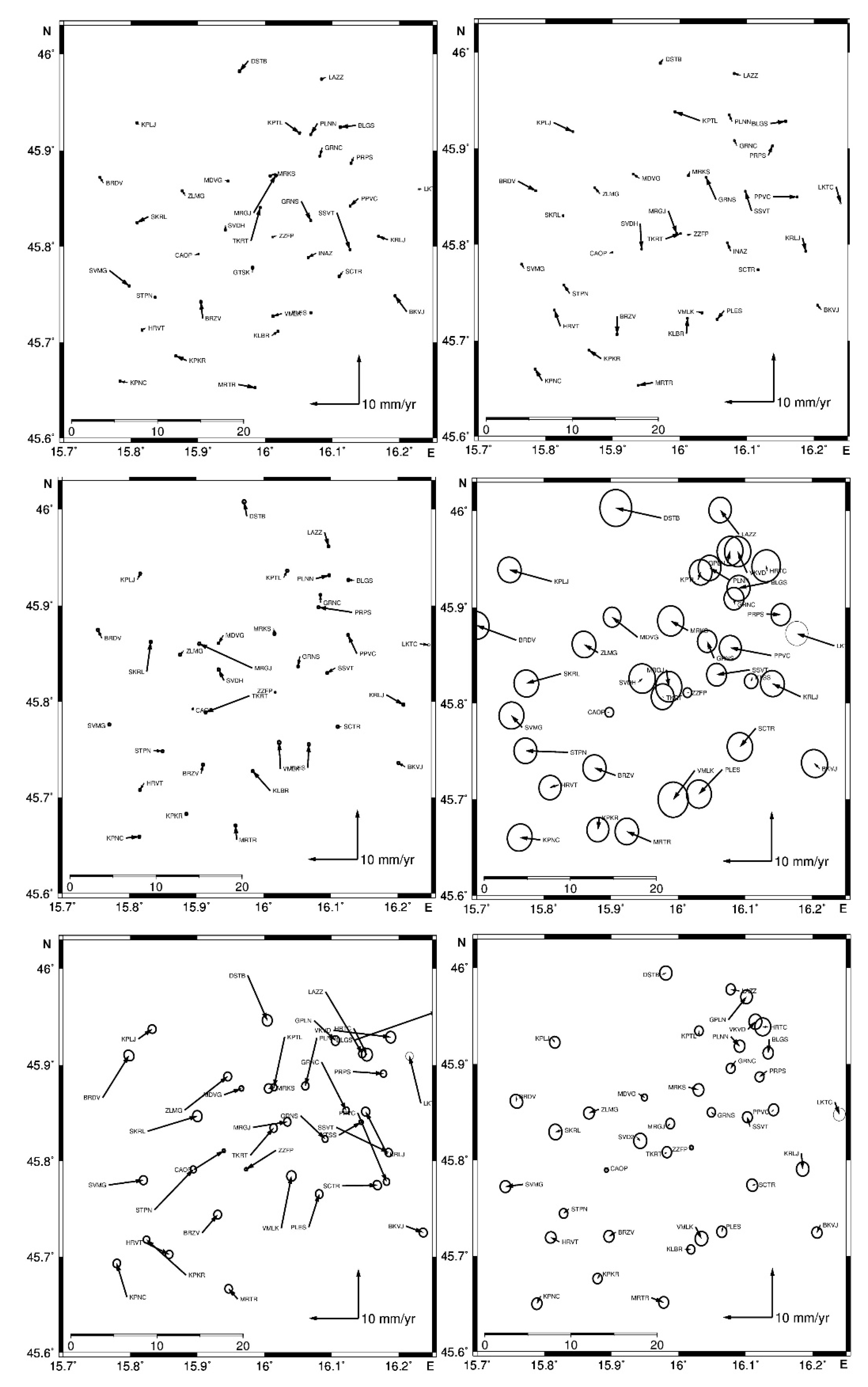
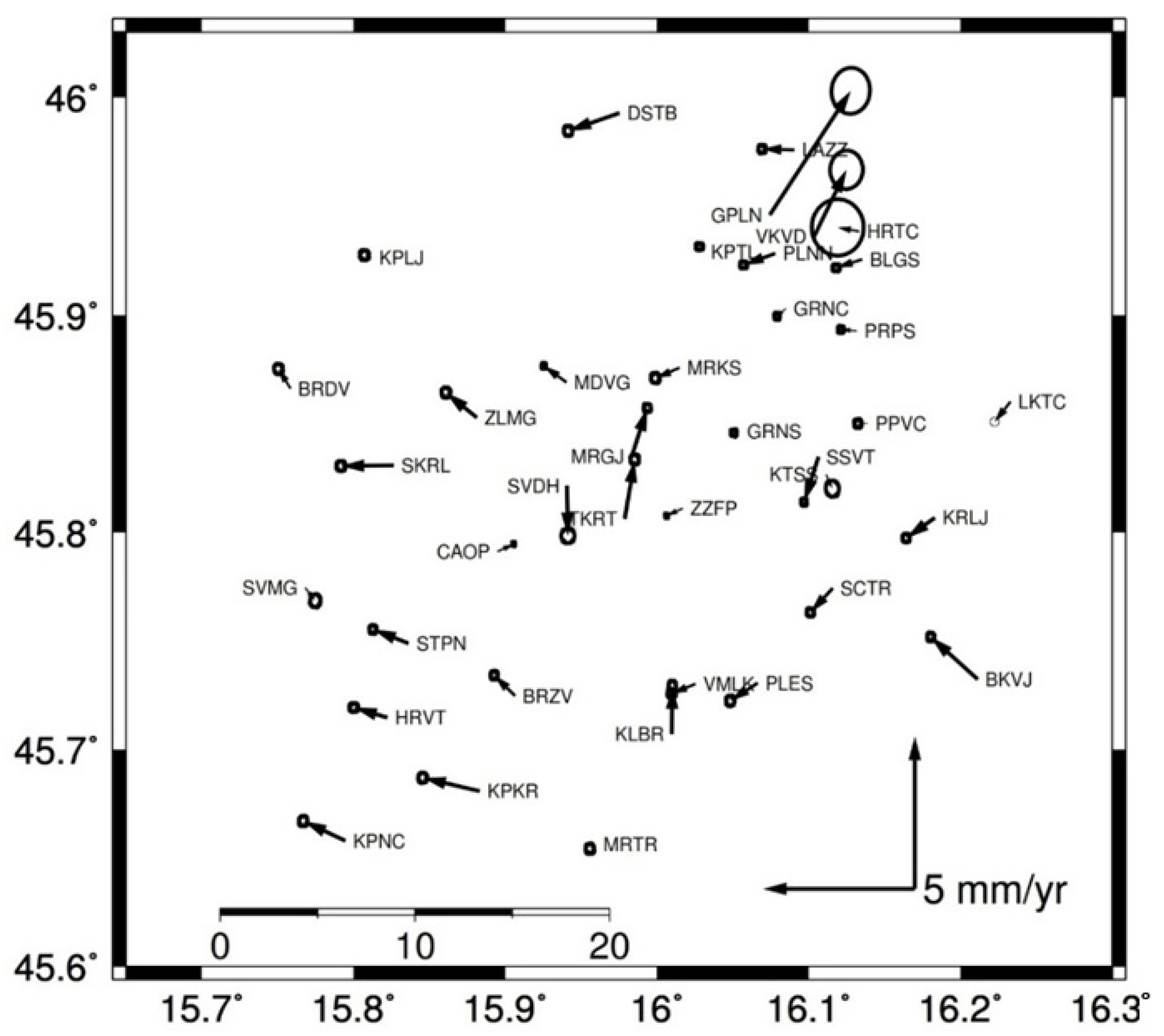

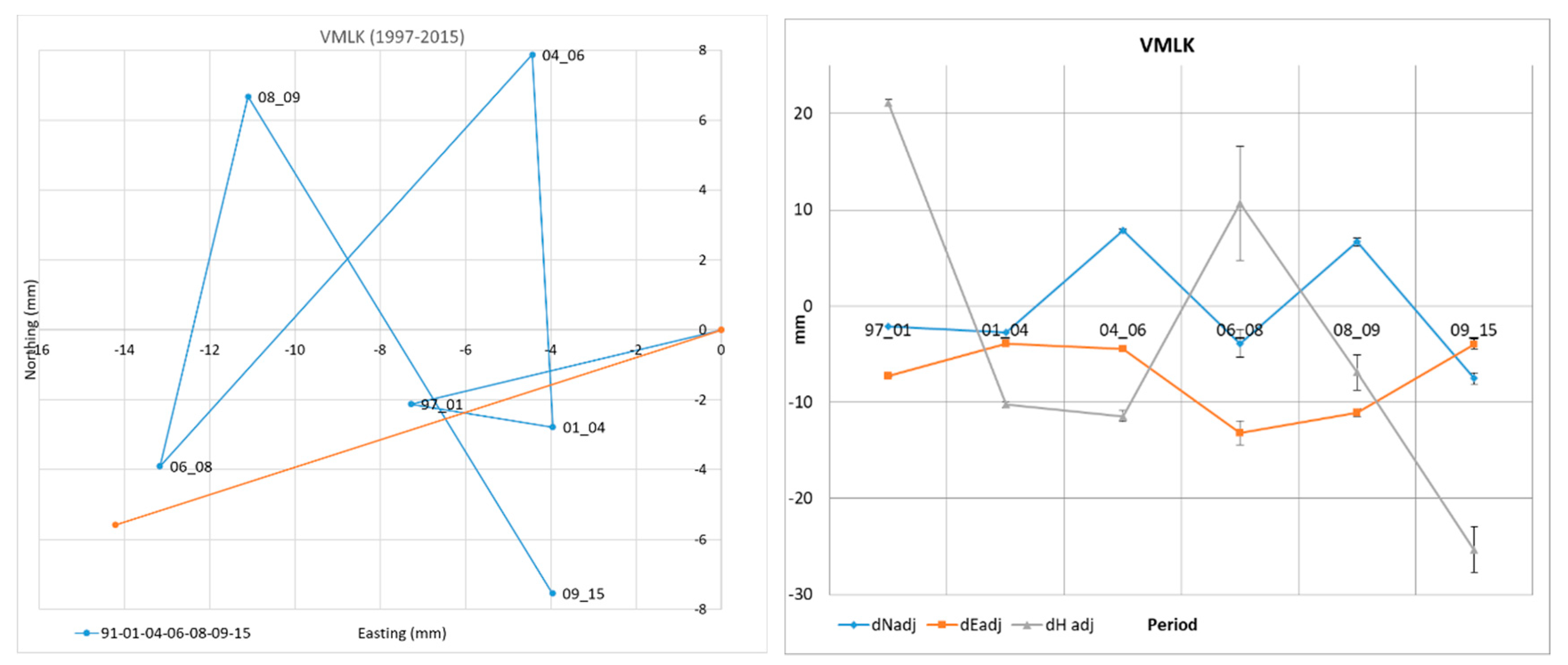


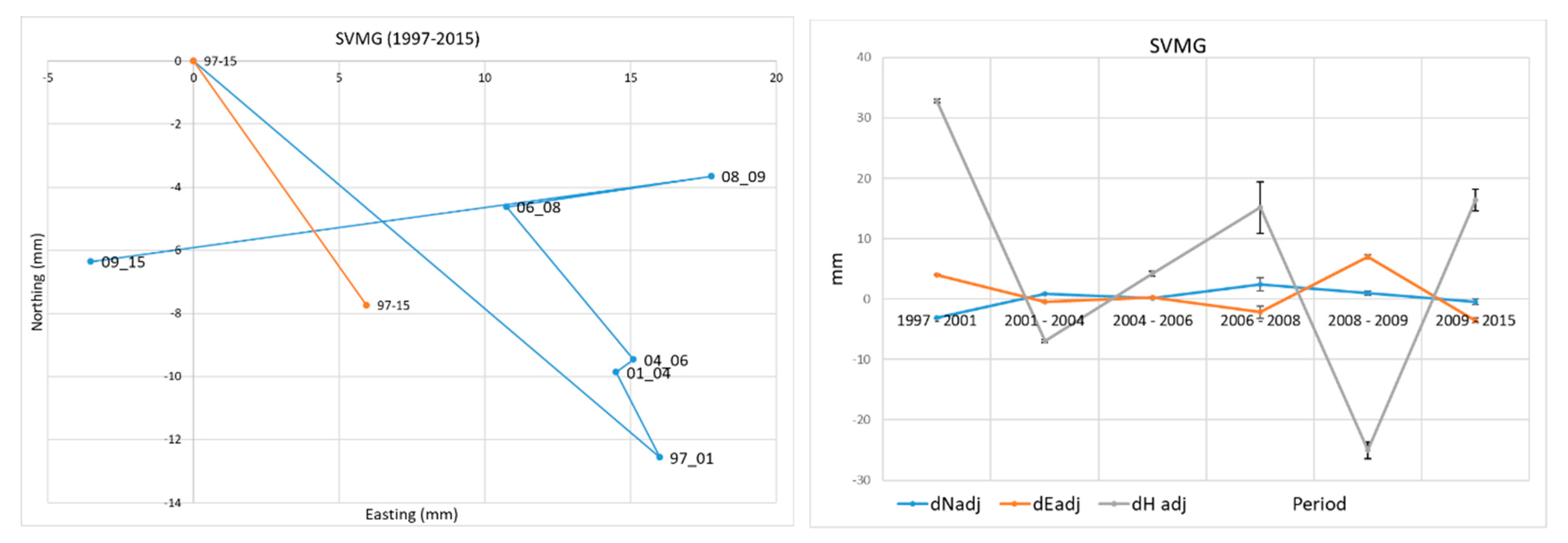
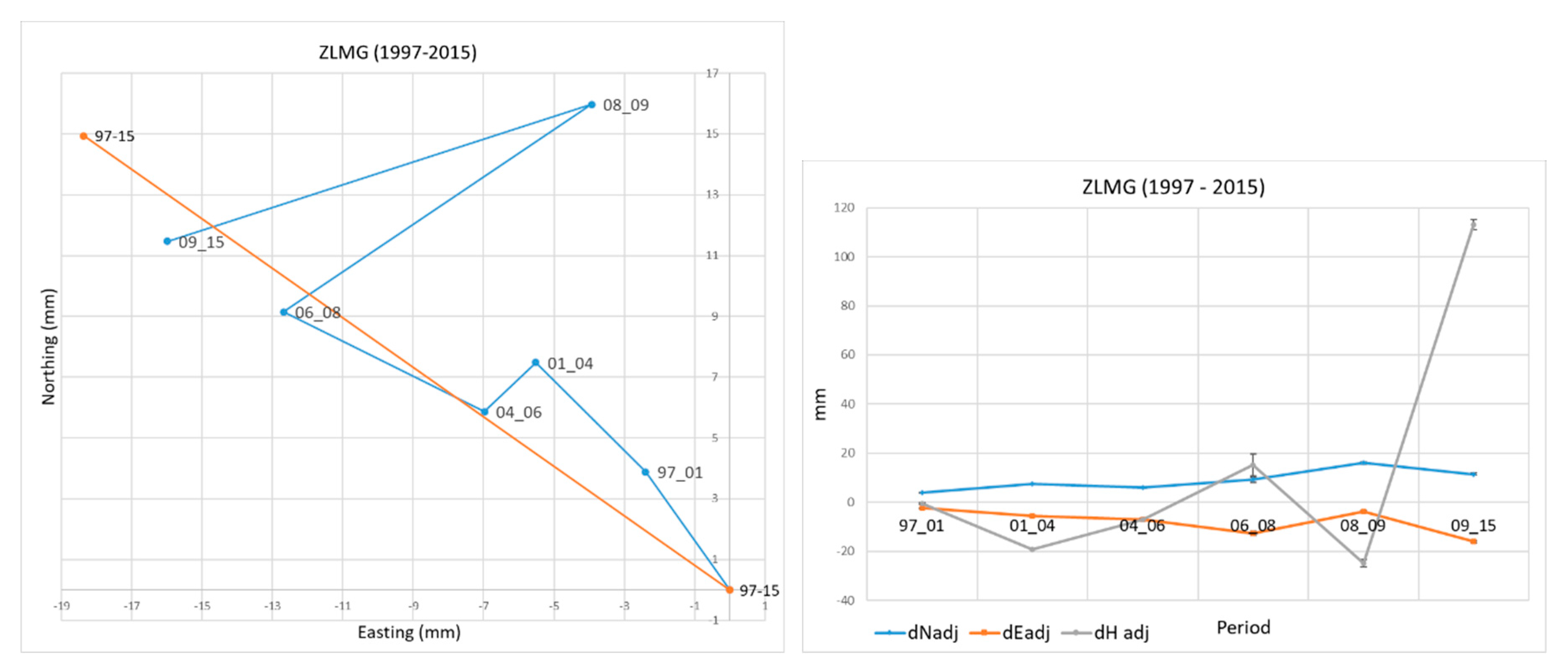
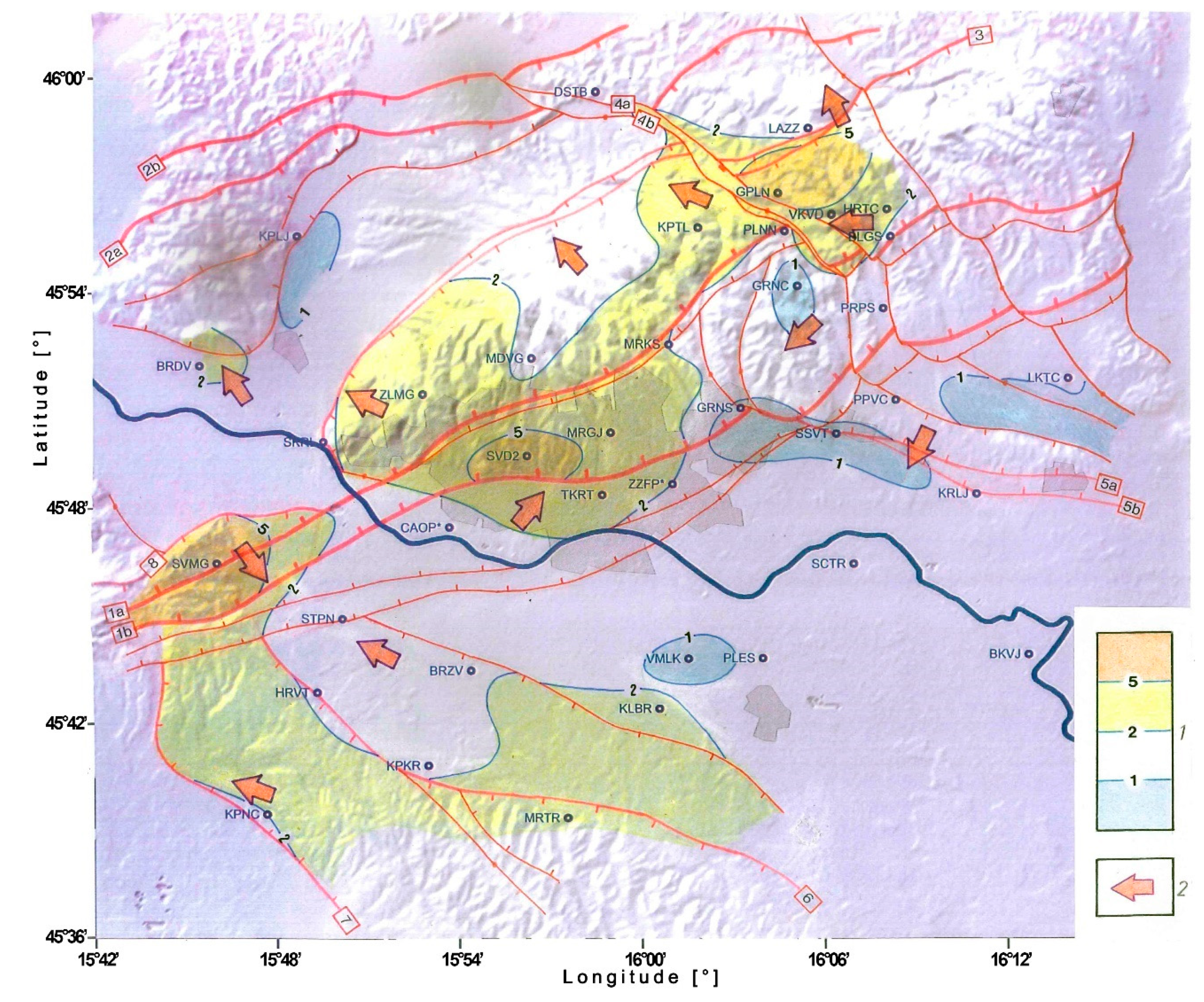
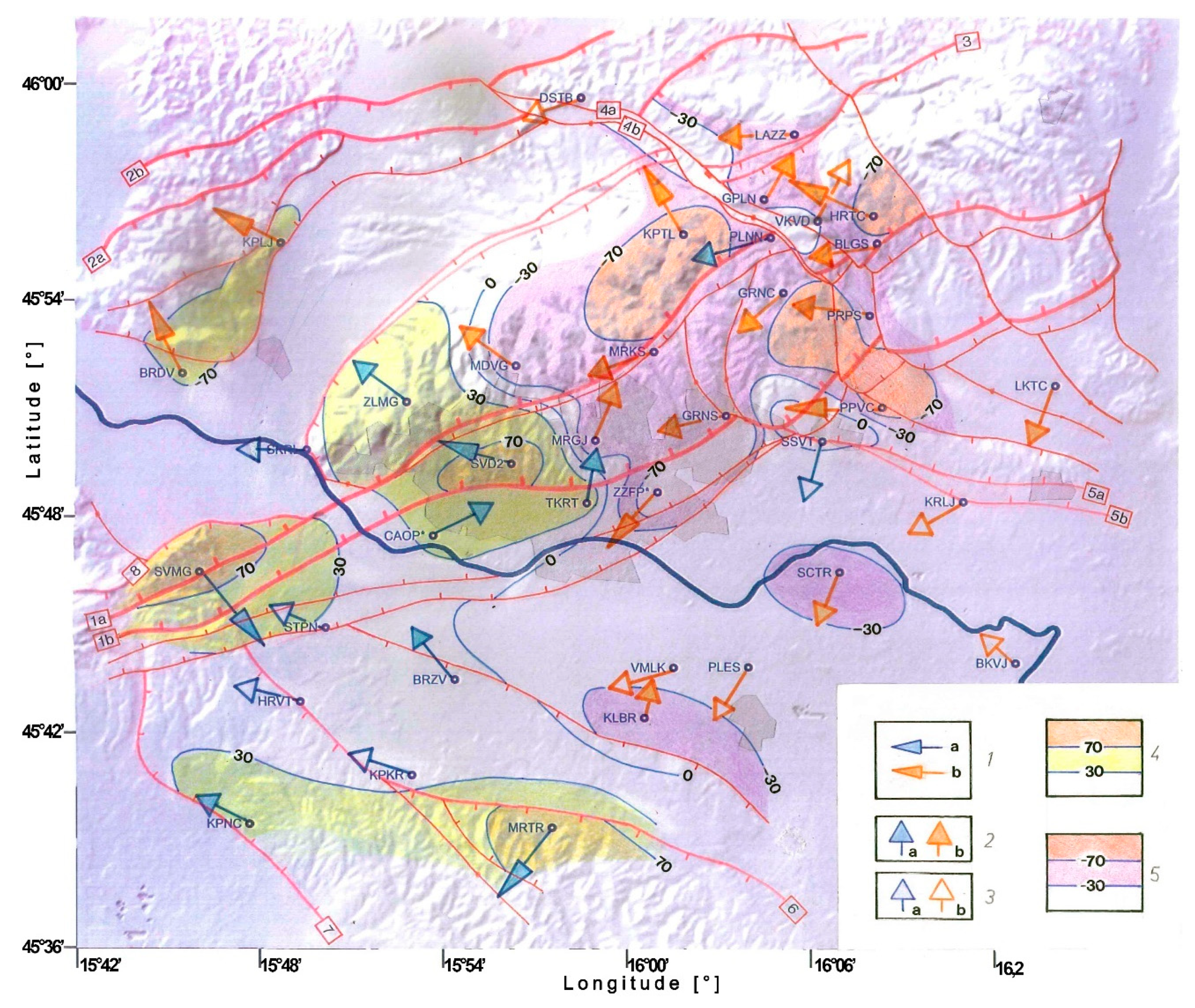
| Campaign | Date (from–to) | Nr. Session | Nr. Pts | Nr. GPS Receivers | Nr. Epochs/pt |
|---|---|---|---|---|---|
| Zagreb 1997 | 27.10.1997–29.10.1997 | 2 | 43 | 27 | 2880 |
| Zagreb 2001 | 25.06.2001–28.06.2001 | 3 | 40 | 16 | 2880 |
| Zagreb 2003 | 22.06.2003–23.06.2003 | 1 | 13 | 13 | 2880 |
| Zagreb 2004 | 17.06.2004–20.06.2004 | 3 | 39 | 13 | 2880 |
| Zagreb 2005 | 10.09.2005–11.09.2005 | 1 | 11 | 11 | 2880 |
| Zagreb 2006 | 22.06.2006–25.06.2006 | 3 | 41 | 15 | 2880 |
| Zagreb 2007 | 13.07.2007–15.07.2007 | 2 | 21 | 13 | 2880 |
| Zagreb 2008 | 10.06.2008–13.06.2008 | 3 | 41 | 15 | 2880 |
| Zagreb 2009 | 11.06.2009–14.06.2009 | 3 | 41 | 15 | 2880 |
| Zagreb 2015 | 11.06.2015–14.06.2015 | 3 | 41 | 15 | 5760 |
| Name | λ | φ | vφ (mm/yr) | +/− mm | vλ (mm/yr) | +/− mm | vH (mm/yr) | +/− mm | vhor (mm/yr) | vsum (mm/yr) | Azimuth° | V. ang° |
|---|---|---|---|---|---|---|---|---|---|---|---|---|
| BKVJ | 16.2114 | 45.7323 | 1.4 | 0.06 | −1.6 | 0.05 | −0.2 | 0.23 | 2.1 | 2.1 | 312.1 | −6.0 |
| BLGS | 16.1353 | 45.9257 | −0.3 | 0.05 | −0.9 | 0.05 | −1.4 | 0.20 | 0.9 | 1.6 | 252.0 | −56.2 |
| BRDV | 15.7585 | 45.8662 | 0.7 | 0.07 | −0.4 | 0.06 | −2.3 | 0.29 | 0.8 | 2.4 | 328.4 | −71.5 |
| BRZV | 15.9065 | 45.7247 | 0.7 | 0.06 | −0.7 | 0.05 | 0.8 | 0.25 | 1.0 | 1.3 | 314.6 | 40.2 |
| CAOP | 15.8949 | 45.7912 | 0.3 | 0.03 | 0.5 | 0.02 | 1.3 | 0.11 | 0.6 | 1.5 | 64.7 | 66.2 |
| DSTB | 15.9753 | 45.9929 | −0.6 | 0.07 | −1.7 | 0.06 | −0.1 | 0.27 | 1.8 | 1.8 | 250.8 | −4.2 |
| GPLN | 16.0743 | 45.9460 | 4.1 | 0.31 | 2.7 | 0.26 | −7.8 | 1.53 | 4.9 | 9.2 | 33.1 | −58.1 |
| GRNC | 16.0850 | 45.9031 | −0.3 | 0.05 | −0.3 | 0.04 | −0.5 | 0.18 | 0.4 | 0.6 | 228.1 | −52.6 |
| GRNS | 16.0544 | 45.8466 | −0.1 | 0.05 | −0.2 | 0.04 | −0.5 | 0.20 | 0.2 | 0.5 | 255.3 | −68.2 |
| HRTC | 16.1333 | 45.9385 | 0.1 | 0.38 | −0.7 | 0.35 | −2.1 | 1.45 | 0.7 | 2.2 | 280.4 | −70.9 |
| HRVT | 15.8225 | 45.7147 | 0.3 | 0.06 | −1.1 | 0.06 | 0.0 | 0.25 | 1.2 | 1.2 | 286.6 | 0.5 |
| KLBR | 16.0097 | 45.7070 | 1.6 | 0.07 | 0.0 | 0.05 | −2.8 | 0.24 | 1.6 | 3.2 | 0.7 | −60.4 |
| KPKR | 15.8832 | 45.6809 | 0.4 | 0.07 | −1.9 | 0.06 | 0.2 | 0.24 | 1.9 | 1.9 | 283.2 | 5.3 |
| KPLJ | 15.8118 | 45.9265 | 0.1 | 0.07 | −0.2 | 0.06 | −0.7 | 0.24 | 0.2 | 0.7 | 289.2 | −70.0 |
| KPNC | 15.7947 | 45.6580 | 0.7 | 0.07 | −1.4 | 0.06 | 1.3 | 0.26 | 1.5 | 2.0 | 295.1 | 40.7 |
| KPTL | 16.0304 | 45.9291 | 0.2 | 0.05 | −0.1 | 0.05 | −2.4 | 0.21 | 0.2 | 2.4 | 324.8 | −85.0 |
| KRLJ | 16.1832 | 45.8068 | −0.7 | 0.06 | −1.0 | 0.05 | −0.2 | 0.23 | 1.2 | 1.2 | 234.8 | −7.4 |
| KTSS | 16.1114 | 45.8268 | −0.5 | 0.11 | 0.2 | 0.09 | 0.6 | 0.45 | 0.5 | 0.8 | 155.9 | 47.9 |
| LAZZ | 16.0906 | 45.9759 | 0.0 | 0.06 | −1.1 | 0.05 | −0.8 | 0.22 | 1.1 | 1.4 | 271.6 | −38.1 |
| LKTC | 16.2330 | 45.8604 | −0.7 | 0.06 | −0.5 | 0.06 | −0.7 | 0.25 | 0.8 | 1.1 | 217.8 | −38.7 |
| MDVG | 15.9404 | 45.8691 | 0.5 | 0.04 | −0.8 | 0.03 | −1.2 | 0.15 | 0.9 | 1.5 | 305.8 | −53.1 |
| MRGJ | 15.9834 | 45.8351 | 1.6 | 0.06 | 0.5 | 0.05 | −1.4 | 0.28 | 1.7 | 2.2 | 17.8 | −39.6 |
| MRKS | 16.0149 | 45.8758 | −0.3 | 0.07 | −0.8 | 0.06 | −1.8 | 0.32 | 0.9 | 2.0 | 247.0 | −64.0 |
| MRTR | 15.9596 | 45.6562 | −0.1 | 0.07 | −0.2 | 0.06 | 3.0 | 0.26 | 0.2 | 3.0 | 235.6 | 85.6 |
| PLES | 16.0663 | 45.7307 | −0.6 | 0.07 | −0.9 | 0.06 | −0.1 | 0.28 | 1.1 | 1.1 | 236.8 | −6.9 |
| PLNN | 16.0780 | 45.9284 | −0.4 | 0.05 | −1.1 | 0.05 | 0.7 | 0.22 | 1.1 | 1.3 | 250.1 | 31.0 |
| PPVC | 16.1388 | 45.8503 | 0.0 | 0.06 | −0.3 | 0.05 | −1.5 | 0.22 | 0.3 | 1.5 | 268.2 | −77.5 |
| PRPS | 16.1317 | 45.8927 | 0.1 | 0.05 | −0.5 | 0.04 | −1.1 | 0.20 | 0.5 | 1.2 | 275.4 | −63.3 |
| SCTR | 16.1159 | 45.7744 | −0.8 | 0.06 | −0.7 | 0.05 | −2.5 | 0.23 | 1.1 | 2.7 | 222.8 | −66.0 |
| SKRL | 15.8265 | 45.8309 | 0.0 | 0.07 | −1.7 | 0.06 | 0.8 | 0.27 | 1.7 | 1.9 | 269.3 | 23.3 |
| SSVT | 16.1065 | 45.8349 | −1.5 | 0.05 | −0.5 | 0.04 | 0.1 | 0.20 | 1.6 | 1.6 | 197.9 | 4.4 |
| STPN | 15.8364 | 45.7489 | 0.5 | 0.06 | −1.2 | 0.05 | 0.7 | 0.21 | 1.3 | 1.4 | 291.3 | 28.2 |
| SVDH | 15.9407 | 45.8216 | −1.7 | 0.10 | 0.0 | 0.09 | 4.8 | 0.43 | 1.7 | 5.1 | 179.0 | 71.0 |
| SVMG | 15.7681 | 45.7746 | −0.4 | 0.09 | 0.3 | 0.07 | 12.0 | 0.35 | 0.5 | 12.1 | 142.5 | 87.4 |
| TKRT | 15.9787 | 45.8062 | 2.0 | 0.07 | 0.3 | 0.06 | 1.2 | 0.28 | 2.0 | 2.3 | 9.6 | 31.1 |
| VKVD | 16.1035 | 45.9361 | 2.2 | 0.26 | 1.1 | 0.22 | −1.1 | 1.35 | 2.4 | 2.7 | 25.9 | −24.8 |
| VMLK | 16.0255 | 45.7302 | −0.3 | 0.06 | −0.8 | 0.06 | −0.2 | 0.27 | 0.8 | 0.9 | 248.6 | −15.8 |
| ZLMG | 15.8813 | 45.8528 | 0.8 | 0.07 | −1.0 | 0.06 | 2.3 | 0.28 | 1.3 | 2.6 | 309.1 | 59.8 |
| ZZFP | 16.0170 | 45.8112 | −0.3 | 0.03 | −0.5 | 0.02 | −1.9 | 0.11 | 0.6 | 2.0 | 244.7 | −73.0 |
| vφ (mm/yr) | vλ (mm/yr) | vH (mm/yr) | vhor (mm/yr) | vsum (mm/yr) | |
|---|---|---|---|---|---|
| max | 4.09 | 2.67 | 12.04 | 4.88 | 12.05 |
| min | 0.01 | 0.02 | 0.01 | 0.20 | 0.53 |
| avg | 0.70 | 0.76 | 1.71 | 1.14 | 2.28 |
Publisher’s Note: MDPI stays neutral with regard to jurisdictional claims in published maps and institutional affiliations. |
© 2020 by the authors. Licensee MDPI, Basel, Switzerland. This article is an open access article distributed under the terms and conditions of the Creative Commons Attribution (CC BY) license (http://creativecommons.org/licenses/by/4.0/).
Share and Cite
Đapo, A.; Pavasović, M.; Pribičević, B.; Prelogović, E. Combined Space–Time Analysis of Geodetic and Geological Surveys for Evaluation of the Reliability of the Position of Points in the Geodynamic Network of the City of Zagreb. Geosciences 2020, 10, 498. https://doi.org/10.3390/geosciences10120498
Đapo A, Pavasović M, Pribičević B, Prelogović E. Combined Space–Time Analysis of Geodetic and Geological Surveys for Evaluation of the Reliability of the Position of Points in the Geodynamic Network of the City of Zagreb. Geosciences. 2020; 10(12):498. https://doi.org/10.3390/geosciences10120498
Chicago/Turabian StyleĐapo, Almin, Marko Pavasović, Boško Pribičević, and Eduard Prelogović. 2020. "Combined Space–Time Analysis of Geodetic and Geological Surveys for Evaluation of the Reliability of the Position of Points in the Geodynamic Network of the City of Zagreb" Geosciences 10, no. 12: 498. https://doi.org/10.3390/geosciences10120498
APA StyleĐapo, A., Pavasović, M., Pribičević, B., & Prelogović, E. (2020). Combined Space–Time Analysis of Geodetic and Geological Surveys for Evaluation of the Reliability of the Position of Points in the Geodynamic Network of the City of Zagreb. Geosciences, 10(12), 498. https://doi.org/10.3390/geosciences10120498







